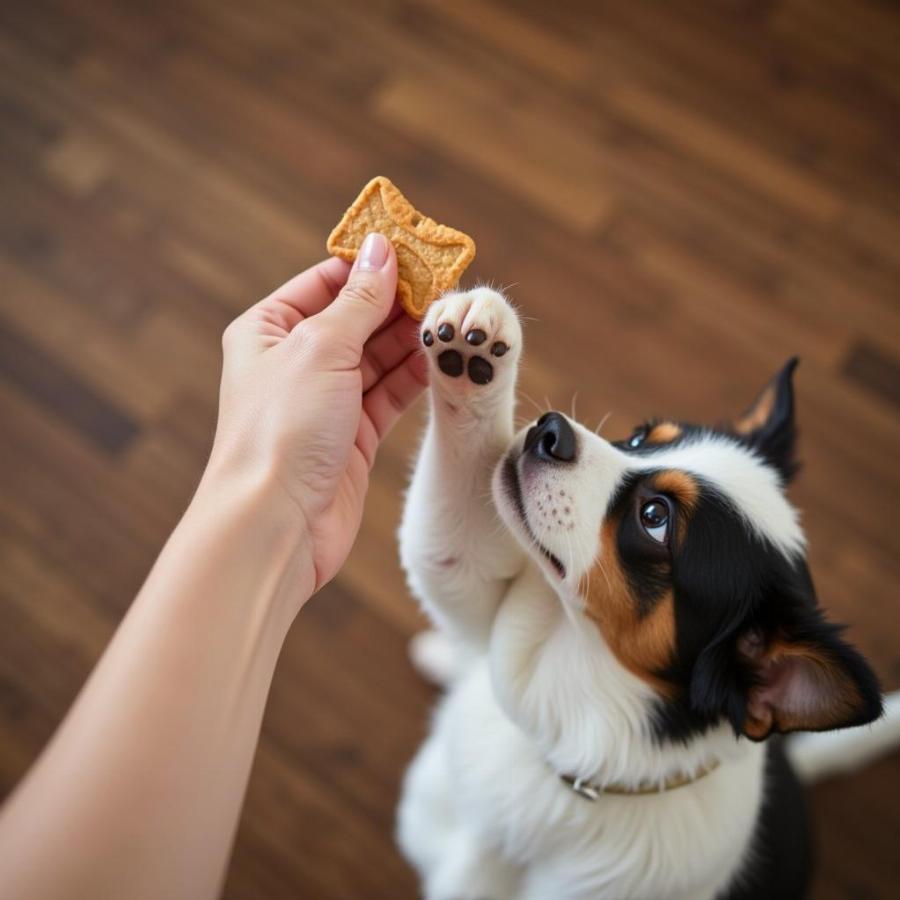The dog high five is more than just a cute trick; it’s a fantastic way to bond with your furry friend, build trust, and even enhance their cognitive skills. It’s a positive reinforcement training method that can be easily taught with patience and consistency. This guide will cover everything you need to know about teaching your dog this fun trick, from understanding the underlying principles to troubleshooting common challenges.
Why Teach Your Dog a High Five?
Beyond the sheer entertainment value, teaching your dog a high five offers several benefits. It strengthens your bond, improves communication, and provides mental stimulation. Plus, it’s a great party trick! This simple act of raising a paw builds trust and reinforces positive interactions. Just like best beginner dogs, learning a high five can be a stepping stone to more complex commands and tricks.
Building a Foundation of Trust and Communication
Training your dog, even with a simple trick like a high five, is all about clear communication and positive reinforcement. Much like understanding how many years in a dog generation helps us communicate their lifespan, teaching tricks helps us understand their learning process. By rewarding desired behaviors, you are showing your dog what you expect and building a positive association with training. This foundation of trust is crucial for a happy and harmonious relationship.
How to Teach Your Dog the High Five
The key to success is breaking down the process into small, manageable steps. Start by holding a treat in your closed fist. As your dog sniffs and paws at your hand, say “high five” and open your hand to reveal the treat. Gradually raise your hand a bit higher each time.
Step-by-Step High Five Training
- Lure with a Treat: Hold a treat in your closed fist and let your dog sniff and paw at it.
- Mark and Reward: The moment your dog lifts their paw, say “high five” and give them the treat.
- Raise the Bar (Literally): Gradually increase the height of your hand as your dog gets the hang of it.
- Introduce the Open Hand: Start offering your open hand for the high five.
Troubleshooting Common High Five Challenges
What if your dog isn’t lifting their paw? Try tapping the back of their paw gently to encourage the movement. Remember patience is key. Similar to understanding the size of dogs and their individual needs, training also requires considering their personality and learning style. Some dogs learn faster than others.
 Dog learning to high five with a treat
Dog learning to high five with a treat
Beyond the Basic High Five: Taking it to the Next Level
Once your dog has mastered the basic high five, you can add variations like the “double high five” or even a “high ten”! The possibilities are endless. This not only adds to the fun but also provides continued mental stimulation for your dog. Just like knowing the dog days of summer 2023 helps us understand seasonal care needs, mastering new tricks helps us understand our dog’s intelligence and adaptability.
Advanced High Five Tricks and Variations
- Double High Five: Teach your dog to high five with both paws!
- High Ten: Similar to the double high five, but with your both hands open.
- Moving High Five: Practice the high five while walking.
“Consistent practice and positive reinforcement are the keys to success. Celebrate each small victory and remember to keep the training sessions fun and engaging,” says renowned dog trainer, Sarah Miller, CPDT-KA.
Conclusion
Teaching your dog a high five is a rewarding experience for both you and your furry companion. It strengthens your bond, enhances communication, and provides valuable mental stimulation. With patience, consistency, and positive reinforcement, you can master this fun trick and enjoy countless moments of joy with your dog. Remember, much like choosing the right food based on wsava guidelines dog food, training should be tailored to your individual dog’s needs and learning style.
FAQ
- How long does it take to teach a dog a high five? It varies, but with consistent practice, most dogs learn within a few days to a week.
- What if my dog is left-pawed? The same principles apply; simply use your opposite hand.
- Can older dogs learn new tricks? Absolutely! Older dogs can learn new tricks with patience and positive reinforcement.
- What kind of treats should I use? Use small, high-value treats that your dog loves.
- Should I use a clicker? A clicker can be helpful for marking the desired behavior.
- My dog keeps biting my hand instead of giving a high five. Try holding the treat further back in your hand or using a toy instead.
- What if my dog loses interest? Keep training sessions short and fun.
Beaut Dogs is your ultimate resource for all things dog-related, offering expert advice and guidance on every aspect of dog ownership. From breed selection to comprehensive care guides, we are dedicated to providing reliable and valuable information to the dog-loving community. For personalized support and detailed answers to your dog-related questions, please contact us via Email at [email protected]. We’re here to help!